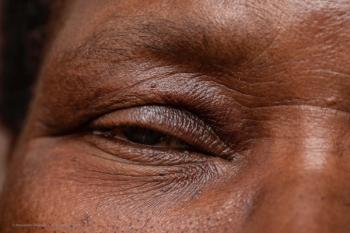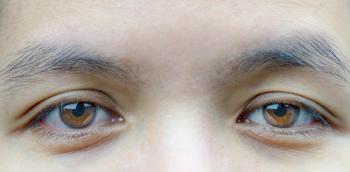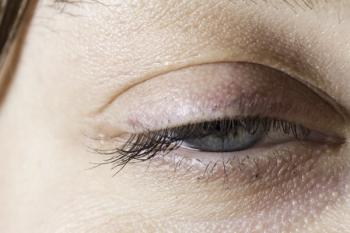
Viewing ptosis through a biopsychosocial lens
Low-lying lids affect much more than patients' visual field, with implications for visual quality and their self-esteem.
Special to Optometry Times®
It is well understood that ptosis or low-lying lids can interfere with patients' field of vision; however, not as obvious are other visual implications that include inducing irregular astigmatism, higher-order aberrations, and a loss of contrast sensitivity.
Still, those factors represent only the physiologic consequences of ptosis. But what about its impact on the person behind the eyes?
Background
Acquired blepharoptosis—ptosis—is a condition characterized by a low-lying upper eyelid margin when the eye is in primary gaze.1
The condition is common and affects millions of people worldwide, with one study finding that the prevalence among adults older than 50 was about 11.5%.2,3
It has visual consequences as well as important psychosocial ramifications causing patients to feel self-conscious about their appearance.4,5 But with surgery as the standard treatment, many of us refer out more severe cases, and often give little thought to identifying mild, asymptomatic ptosis.
Related:
Yet according to market research, of 10,000 women surveyed, 60% self-identified as having low-lying lids.6Even more powerful, 80% of them wished that their doctor had discussed the issue with them. There is a clear disconnect.
In 2020, the FDA approved the novel Upneeq (oxymetazoline hydrochloride ophthalmic solution 0.1%; RVL Pharmaceuticals, Inc.), as a safe, convenient, and effective once-a-day drop.
The agent is a direct-acting alpha-adrenergic receptor agonist, which, when administered to the eye, is believed to selectively target the Müller muscle and elevate the upper eyelid.
Approval was based on two six-week, randomized, double-masked, placebo-controlled phase 3 efficacy studies of 304 patients that found oxymetazoline was associated with significant improvements compared with placebo in primary superior visual field and eyelid lift.7
Upneeq's availability requires us to shift our thinking about ptosis and its management. To provide total eye care, we must look for low lying lids, ask questions, listen to the answers, and most importantly, consider the whole patient.
Applying the biopsychosocial disease model to ptosis
In 1977, psychiatrist George Engel established the biopsychosocial model of clinical care.8 He believed that to properly respond to patients’ suffering—and to give them a sense of being understood—clinicians must consider the biological, psychological, and social dimensions of illness.
Many disease states can be viewed through this lens. With cardiovascular disease,for example, there is the biology of heart disease, but there is also the psychological aspect—such as stress and anxiety—that play a role, along with social factors such as diet and exercise.
How does this biopsychosocial model apply to ptosis?
Related:
First there is the condition's biology, including its anatomy and physiology, as well as how it affects quality of vision. It is well established that ptosis decreases the visual field, yet it is critical that we expand this thinking and consider how else a low-lying lid resting on the cornea affects vision.
For example, it is not uncommon for patients with 20/20 visual acuity to complain of blur, yet how often do we think of the lid as the cause?
In addition to visual field loss, ptosis can induce irregular astigmatism, cause a loss of contrast sensitivity, and create higher-order aberrations.9,10
On corneal topography, we can see evidence that a low-lying lid creates irregular astigmatism by looking carefully before and after the lid is lifted.
Snellen visual acuity in the office is a limited measure of visual quality and does not account for contrast sensitivity, although it an important part of vision. A low-lying lid that bisects the pupil causes decreased retinal luminance that leads to contrast sensitivity loss.
Finally, ptosis can cause higher-order aberrations. Although we may not check them, we know their existence matters with innovations in LASIK over the past 3 decades devoted to their reduction to improve results. Data suggest that a low-lying lid induces higher-order aberrations, thereby affecting the quality of vision.
Psychosocial considerations
We cannot overlook the psychosocial consequences of ptosis, a condition which exists on a spectrum of mild to severe.
Certainly, those in the severe category are affected, yet patients with mild ptosis can suffer both interpersonal and intrapersonal consequences. They might feel less confident in their jobs or in their relationships, suffer anxiety, and psychosocial distress.
Related:
For me, however, the best proof that ptosis doesn’t have to be severe to impact people’s impressions of themselves, is that a majority of my patients who ask about Upneeq do not have significant ptosis. They may even be considered “normal” by many, and that is the point—for a large number of individuals, ”normal” is the problem.
Increasingly I am encountering patients without ptosis who recognize the psychosocial value to a lifted, alert, well-rested, "long weekend" look, even in the absence of profound ptosis.
In a study where subjects were asked to rate headshots from a dating site with no other information, those with ptosis were consistently considered less attractive, less likeable, and less successful simply because they had a sleepy appearing eyelid.11
Facial symmetry is a constant feature of beauty across cultures and time, validating the important psychosocial aspect of the appearance of the eyes.
Having the conversation
The struggle then becomes, how do I have this conversation in the office? Maybe we believe that because we manage serious and potentially blinding conditions, we do not have time to talk about ptosis. Perhaps we are just not comfortable discussing patients’ appearances.
If patients present with chief complaints of ptosis, then of course the communication is easy. But many times, patients do not know the word ptosis and they often use adjectives like their eyes look sleepy or heavy, making them appear bored.
Related:
They might even say they have a lazy eye, or one eye looks smaller than the other. We have to be on the lookout for patients describing ptosis inappropriately.
In my mind, in the absence of serious causes of ptosis, any who patient initiates a conversation about ptosis should leave the office with a prescription for Upneeq.
Other patients who may be interested are those who have a history of Botox (Allergan) or premium IOLs, or have used Latisse (Allergan), Lumify (Bausch + Lomb), lash extensions, or colored contacts. These are clues that patients want to have a conversation about ptosis.
The real concern is what to say to patients who have ptosis and are asymptomatic. This is where many may inappropriately apply the old adage: if it ain’t broke, don’t fix it.
Yet, we believe in improvement, and we are in an era of proactive—not reactive—care. We don’t wait for problems.
Additionally, as eye care providers, we frequently bring up conditions that patients don’t complain about, like glaucoma.
Related:
Some may protest, “but that's different, glaucoma is a blinding condition.” Blindness, however, is not the standard of care by which we start to care, and there are many good reasons why we should want to bring up conditions that patients aren’t complaining about.
We want to initiate this conversation about ptosis without making the patients feel badly about themselves. My approach is to say, "You’ve done a great job of taking care of the inside of your eye. Do you have any concerns about the outside?" Then I listen.
If they have identified anything about the appearance of their eyes that bothers them, they will be receptive to learning about ptosis and Upneeq.
Occasionally, patients will say they have no concerns. In that case, I let them know that, as their doctor, I like to keep patients updated about the latest innovations in eye care.
I will tell them that there is a new FDA-approved eye drop for the management of ptosis that gives an alert, well-rested, long weekend look—a lift without surgery.
I listen to their reaction and, if they say nothing, I move on. If they take an interest, I give them a sample. The conversation doesn’t have to be difficult.
Conclusion
Ptosis is very common. Many patients are aware of the condition and wish their eye care provider would discuss it with them.
Yet, ironically, most doctors are missing ptosis because they are not looking for it. Even if they see it, they don’t necessarily know how to bring it up. This condition affects biology, with implications for visual function. It also affects patients' psychosocial health.
Related:
We, as eye care providers, need to do a better job of identifying ptosis. We need to remember the person behind the eyes, and we need to consider the value of lifting the lids the next time we see the 20/20 patient complaining of blur.
References
1. Finsterer J. Ptosis: causes, presentation, and management. Aesthetic Plast Surg. 2003 May-Jun;27(3):193–204. doi: 10.1007/s00266-003-0127-5
2. Sridharan GV, Tallis RC, Leatherbarrow B, Forman WM. A community survey of ptosis of the eyelid and pupil size of elderly people. Age Ageing. 1995 Jan;24(1):21-4. doi: 10.1093/ageing/24.1.21
3. Kim MH, Cho J, Zhao D, et al. Prevalence and associated factors of blepharoptosis in Korean adult population: The Korea National Health and Nutrition Examination Survey 2008–2011. Eye. 2017 Mar;31: 940–946. doi: 10.1038/eye.2017.43
4. Cahill KV, Burns JA, Weber PA. The effect of blepharoptosis on the field of vision. Ophthal Plast Reconstr Surg. 1987;3(3):121-125. doi: 10.1097/00002341-198703030-00001
5. Richards, HS, Jenkinson E, Rumsey N, et al. The psychological well-being and appearance concerns of patients presenting with ptosis. Eye. 2014;28(3):296-302. doi: 10.1038/eye.2013.264
6. RVL market research. Real Self Survey 2019. Data on file.
7. Osmotica Pharmaceuticals plc receives FDA approval for Upneeq (oxymetazoline hydrochloride ophthalmic solution), 0.1% for acquired blepharoptosis (droopy eyelid) in adults. July 9, 2020. Accessed March 1, 2022. https://ir.osmotica.com/news-releases/news-release-details/osmotica-pharmaceuticals-plc-receives-fda-approval-upneeqtm
8. Engel GL. The need for a new medical model: a challenge for biomedicine. Science. 1977 Apr;196(4286):129-36. doi: 10.1126/science.847460
9. Kumar DA, Agarwal A Ms, Prakash G, Boptm NV, Packiyalakshmi S, Agarwal A. Effect of unilateral congenital ptosis on ocular higher order aberrations in children. Med Hypothesis Discov Innov Ophthalmol. 2013;2(3): 86–91.
10. Shen J, Cui H, Tang X, Zhu M, Han W. Optical quality assessment in patients with unilateral congenital ptosis: a matched case-control Study. Journal of Ophthalmology. 2020. https://doi.org/10.1155/2020/2653250
11. Bullock JD, Warwar RE, Bienenfeld DG, et al. Psychosocial implications of blepharoptosis and dermatochalasis. Trans Am Ophthalmol Soc. 2001;99:65-71; discussion 71-72
Newsletter
Want more insights like this? Subscribe to Optometry Times and get clinical pearls and practice tips delivered straight to your inbox.









































